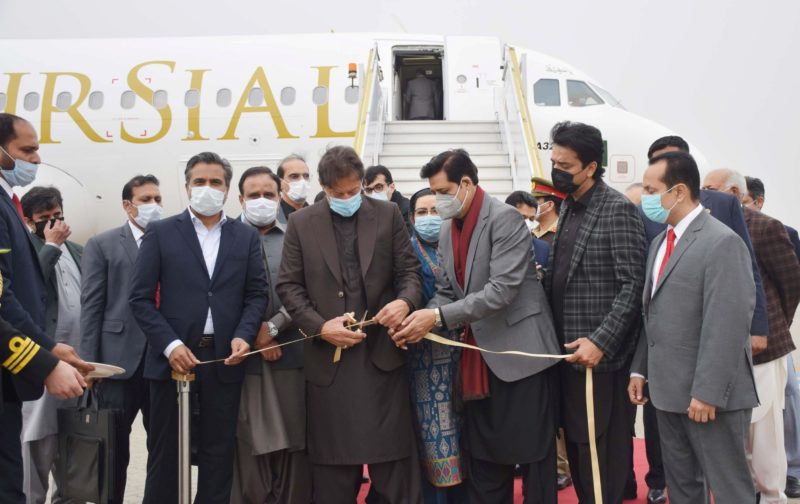Pakistan is the second-largest economy in South Asia, with over 220 million inhabitants and a constantly growing middle class. The economic structure has changed dramatically over the past few decades. In contrast to other sectors, the service sector has increased strongly. Despite manifold challenges over the last two decades, the economy is moving progressively on a higher and sustainable growth path.
However, due to a large set of challenges, the Pakistani aviation sector can be described as ‘the large sleeping giant‘, which needs to wake up from the pandemic effects and immediately grab the opportunities for a better future.
In September, I had the honour to be part of a high-level business delegation from the UAE and Germany visiting the Government of Pakistan and other authorities; with the aim of advising the country on future-proofing its sectors, including aviation. The delegation trip to Karachi and Islamabad was a real eye-opener.
Prior to the pandemic, the air transport sector of Pakistan was forecasted to grow by over 180 percent in the next 20 years.
In 2019, over 500,000 direct and indirect jobs in Pakistan were created by the air transport sector. Today, 1.3 percent of the GDP of Pakistan is supported by inputs to the aviation sector and foreign tourists arriving by air. In 2019 85 percent of all international departure seats from Pakistan were to destinations in the Middle East – especially Dubai with 2.3 million departures.
The fate of the Pakistani airline industry is destined to change for the post-pandemic era. To date, the Pakistani aviation sector has been dealing with a large set of specific challenges: Political instability, security situations, inadequate infrastructure, poor safety culture, inconsistency in state policy, inconsistent tax laws, weak economic growth, poor access to investments and funds, lack of structural reforms and unsupportive economic policies.
Snapshot of Current Aviation Environment in Pakistan
Across the globe, travelling by plane usually costs more than either a bus or train ride for a domestic commute. However it does not legitimise what passengers in Pakistan are charged for domestic flights, in the wake of feeble local competition.
A one-way trip from Karachi to Islamabad cost roughly $45, translating into $0.064 per mile for a domestic flight in Pakistan. An inexpensive Delhi-Mumbai ticket is priced at $55 and around $0.049 per mile by looking over to India. It clearly shows that the difference in fare on a per-mile basis elucidates the industrial mess in Pakistan for a decade.
Despite the recent new market entrants like Fly Jinnah, the market is still limited. After the exit of the privately-owned carrier Shaheen Air back in 2018, Pakistan International Airlines (PIA) has been the primary beneficiary in the domestic market to date. Pakistan has been an oligopolistic airline industry where Serene Air and Air Blue, as privately-owned airlines, compete against each other and the national carrier PIA. Last year, another airline company entered the Pakistani domestic market: AirSial.
Despite Pakistan being the fifth most populous country across the globe, the country’s domestic market performs poorly in terms of available domestic seats divided by the population – Pakistan has about 0.03 seats per person, in comparison with India (0.16), Nepal (0.11) and Bangladesh (0.04).

There is plenty of room to grow when it comes to the total market share of low-cost carriers in Pakistan. Their share is much smaller than some of Pakistan’s neighbour countries like India. In pre-Covid-19 times (2019) there were fewer than 1.3 million low-cost seats departing from Pakistan. This represents 12.6 percent of the total capacity offered in the Pakistani market. In contrast to the country’s current low-cost market, low-cost carriers in India account for about 34 percent of all international seats.
Given the relatively low penetration of low-cost carriers into the Pakistani market to date, various opportunities exist – for instance on services from the Gulf (UAE, Bahrain, Saudi Arabia, Qatar, Oman, Kuwait). Before the pandemic, only three of Pakistan’s top 10 international routes by capacity offered had the presence of at least one low-cost carrier.
The route between Pakistan and the Gulf, with highest low-cost share by capacity offered, is Dubai–Karachi with 21 percent. The low-cost share on most of the routes between Pakistan and the Gulf cities are surprisingly below six percent.
PIA’s struggle
In view of PIA‘s poor safety records, the airline must ensure that its quality of staffing and fleet airworthiness comply with the safety standards; thus satisfying the international regulators such as the EASA, ICAO and the FAA.
The national carrier has been impaired by a chronic lack of profitability due to operational inefficiencies. To be financially sustainable in the post pandemic era, the loss-making carrier must increase revenue, decrease cost and restructure its balance sheet. All these initiatives will help restore confidence among potential customers, restart flight operations on routes presently closed/banned and enhance code-sharing agreements with other airlines to increase overall revenue.
Conclusion
Factors like the high proportion of young people in the population (15-33 years: 63 percent) the growing middle class, the real GDP growth of 3.9 percent in 2020-21 and the government’s increasing awareness about the importance of the aviation industry to a country lay out the foundations for a better future.
Despite the bottlenecks, the investment climate there has improved in the recent years. If we look at the current macro-environment of the Pakistani airlines and airports, structural reforms and economic policy readjustments will be essential to wake up the large sleeping giant. For instance, the Pakistani government has to rationalise the heavy taxes on air tickets in order to make air travel more affordable for the Pakistani people. Air Arabia‘s recent JV with the conglomerate Lakson Group is paving the way for a better, sustainable future for the country’s aviation sector.




